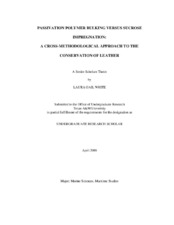| dc.description.abstract | Archaeological leather, especially that which comes from wet excavation sites, has long challenged conservators who wish to preserve it so that it will be long lasting, stable, and informative for cultural analysis. Both the unique structure of the artifact and the detrimental waterlogged environment must be overcome to achieve acceptable results. Many methods have been used to conserve leather with varying degrees of success. The three most common methods of conservation are drying, consolidation, and the use of chemical dressings. The purpose of this research is to compare two methods of consolidation: silicone impregnation and sucrose bulking. Silicone impregnation has been used in leather conservation with excellent results, and its effects have been compared with those of several other consolidation methods, but never to sucrose. In fact, sucrose has never been used as a conservation agent in leather, and has rather been used only in the conservation of waterlogged wood. Parallel testing of polymer bulking and sucrose impregnation confirmed the superiority of samples treated with Passivation Polymer technology in terms of retaining diagnostic characteristics. However, it also proved that sucrose impregnation may serve as a quick, cheap, and reversible method of conservation, particularly for developing conservation programs. | en |


